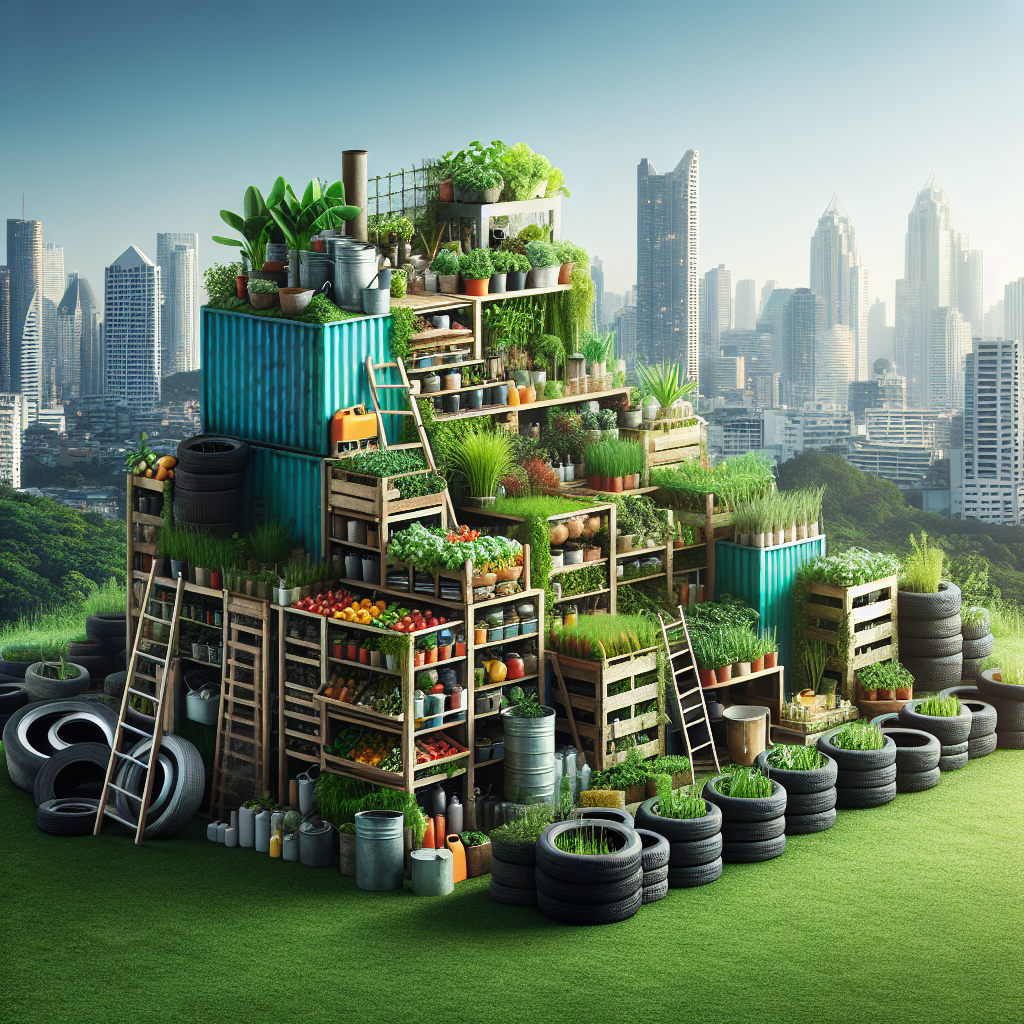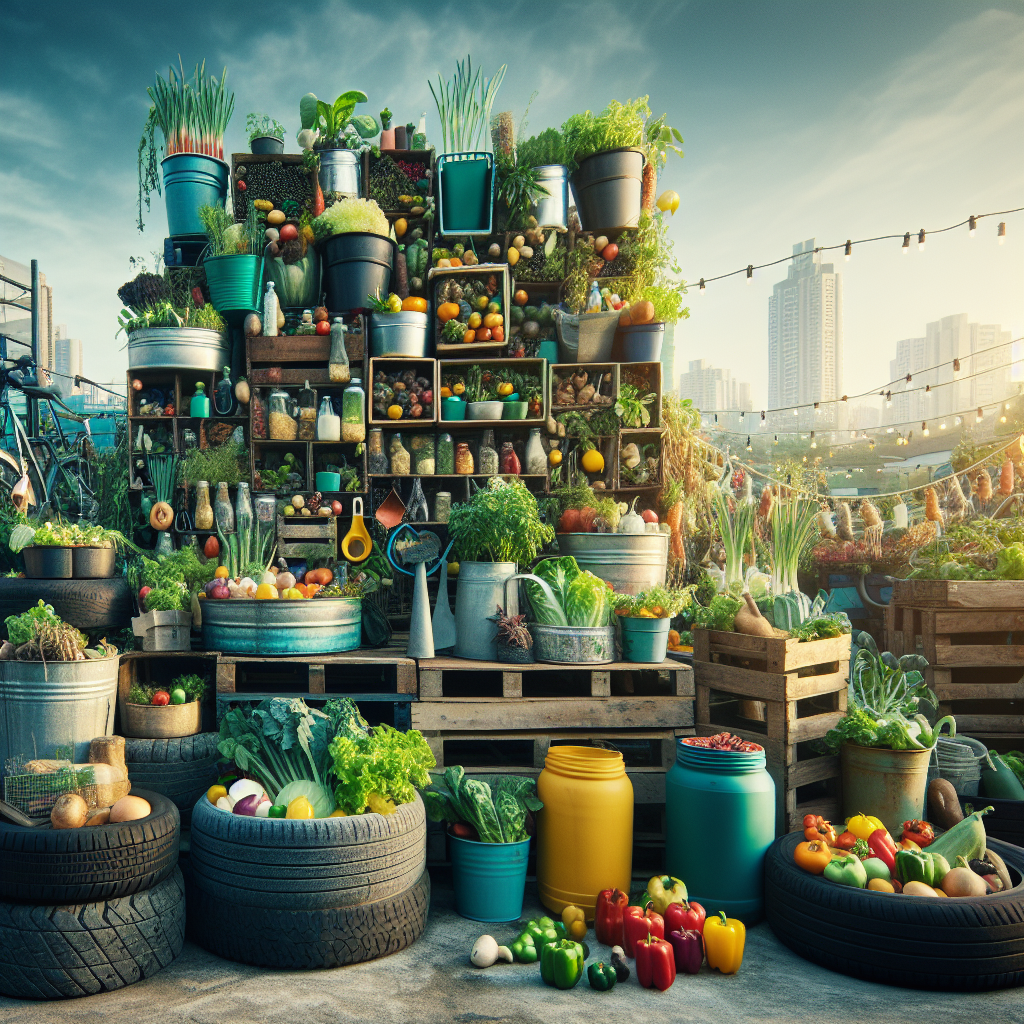
Imagine transforming a barren urban landscape into a thriving oasis of greenery, where fresh produce grows abundantly and the air is filled with the scent of blooming flowers. In this article, we will explore the innovative ways in which you can create a sustainable urban farm using recycled materials. Discover how simple yet effective methods can turn discarded objects into valuable resources, helping to reduce waste and contribute towards a greener, more self-sufficient future. Embark on this exciting journey with us and uncover the secrets to cultivating a flourishing urban farm while making our planet a cleaner and healthier place for all.

Benefits of Creating a Sustainable Urban Farm
Creating a sustainable urban farm brings with it numerous advantages, not only for the environment but also for the community. By adopting sustainable practices, you can reduce waste and minimize the environmental impact. This means finding innovative ways to repurpose materials and minimize the use of non-renewable resources. Additionally, a sustainable urban farm can significantly increase food production, ensuring a local supply of fresh and nutritious food. Lastly, creating such a farm promotes community engagement, fostering a sense of ownership and togetherness among residents.
Choosing the Right Location
When setting up a sustainable urban farm, selecting the right location is crucial. Consider the available space in your urban setting, whether it’s a vacant lot or even rooftop space. Evaluate the amount of sunlight and water accessibility in the area, as these are essential for plant growth. Adequate sun exposure ensures healthy photosynthesis, while easily accessible water sources simplify irrigation. Lastly, assess the soil quality to determine its suitability for farming. Conduct soil tests to determine its nutrient content, pH, and drainage capabilities.
Materials for Building the Infrastructure
One of the key aspects of a sustainable urban farm is utilizing recycled materials to build the infrastructure. By repurposing containers and pallets, you can create raised beds or vertical gardens, maximizing space efficiency. Additionally, repurposed wood and bricks can be used for constructing pathways or retaining walls. These materials help minimize waste and reduce the consumption of new resources. Furthermore, consider using eco-friendly roofing materials, such as recycled shingles or green roofs, to enhance energy efficiency and promote biodiversity.
Soil Preparation and Nutrient Management
To ensure healthy plant growth, it is essential to prepare the soil and manage its nutrient content effectively. Begin by testing the soil quality, including its pH levels, nutrient composition, and organic matter content. Based on the test results, adjust the soil’s pH and enhance its nutrient content using organic amendments. Composting food and yard waste is an effective way to produce nutrient-rich compost, reducing waste and providing a sustainable source of fertilizer. Additionally, utilize organic fertilizers to nourish your plants while maintaining the health of the soil and minimizing environmental harm.

Irrigation and Water Conservation Techniques
Water conservation is paramount in any sustainable farming practice, particularly in urban settings where resources may be limited. Implement rainwater harvesting systems to collect and store rainwater, which can then be used for irrigation. This helps reduce reliance on municipal water sources and prevents water waste. Drip irrigation methods ensure targeted watering, delivering water directly to the plant roots, minimizing evaporation and runoff. Furthermore, consider implementing greywater recycling systems to reuse water from household activities such as laundry or dishwashing in irrigation.
Choosing Suitable Crops
Selecting the right crops based on the local climate and conditions is vital for a sustainable urban farm’s success. Take into account the prevailing weather patterns, temperature fluctuations, and overall climate in your area. Opt for drought-tolerant crop varieties that can withstand periods of limited water availability. Furthermore, consider using companion planting techniques, where certain plants complement each other’s growth and deter pests. This promotes biodiversity while conserving space and resources.

Pest and Disease Control Methods
Implementing natural pest and disease control methods is an essential part of sustainable urban farming. Rather than relying on chemical pesticides, which can harm the environment and beneficial organisms, consider natural pest management strategies. This includes techniques such as crop rotation, which disrupts pest life cycles, and physical barriers like nets or row covers. Introducing beneficial insects and companion plants can help control pests, as they attract natural predators. Additionally, applying organic remedies like neem oil or garlic spray can effectively manage certain pests without harmfully impacting the ecosystem.
Implementing Sustainable Energy Solutions
Sustainable energy solutions play a vital role in reducing the environmental impact of urban farming. Install solar panels to generate electricity for powering farm infrastructure and equipment. By harnessing the power of the sun, you can reduce reliance on non-renewable energy sources and lower your carbon footprint. Additionally, consider using wind turbines to generate energy, especially in areas with consistent wind speeds. Another sustainable energy solution is biogas production, where organic waste is turned into methane gas through anaerobic digestion. This biogas can then be used for cooking or heating purposes.

Promoting Biodiversity and Habitat Creation
Creating a sustainable urban farm provides an opportunity to promote biodiversity and create habitats for various species. Planting pollinator-friendly flowers, such as lavender, sunflowers, or bee balm, attracts bees and other beneficial insects crucial for crop pollination. Additionally, designating wildlife-friendly spaces within your farm, such as birdhouses or insect hotels, encourages the presence of diverse animal species. By supporting beneficial insects and birds, you can naturally control pests and create a more balanced ecosystem.
Educating and Engaging the Community
A sustainable urban farm can serve as an educational hub and a means to engage the community. Organize workshops and demonstrations to teach residents about sustainable farming practices, composting, and other eco-friendly activities. Involving local schools and educational institutions allows young learners to participate in hands-on activities and develop an understanding of sustainable agriculture. Furthermore, collaborate with local organizations and initiatives to create a network of support and knowledge-sharing within the community. By educating and engaging the community, you can foster a sense of environmental consciousness and inspire others to adopt sustainable practices.
Creating a sustainable urban farm using recycled materials is not only a responsible choice for the environment but also a means to promote community engagement and enhance food security. By considering the right location, utilizing recycled materials, managing soil nutrients, implementing sustainable irrigation techniques, choosing suitable crops, controlling pests naturally, adopting renewable energy solutions, promoting biodiversity, and engaging the community, you can create a vibrant and sustainable urban farm that benefits both people and the planet. Start your sustainable farming journey today and be part of the solution for a greener and healthier future.








